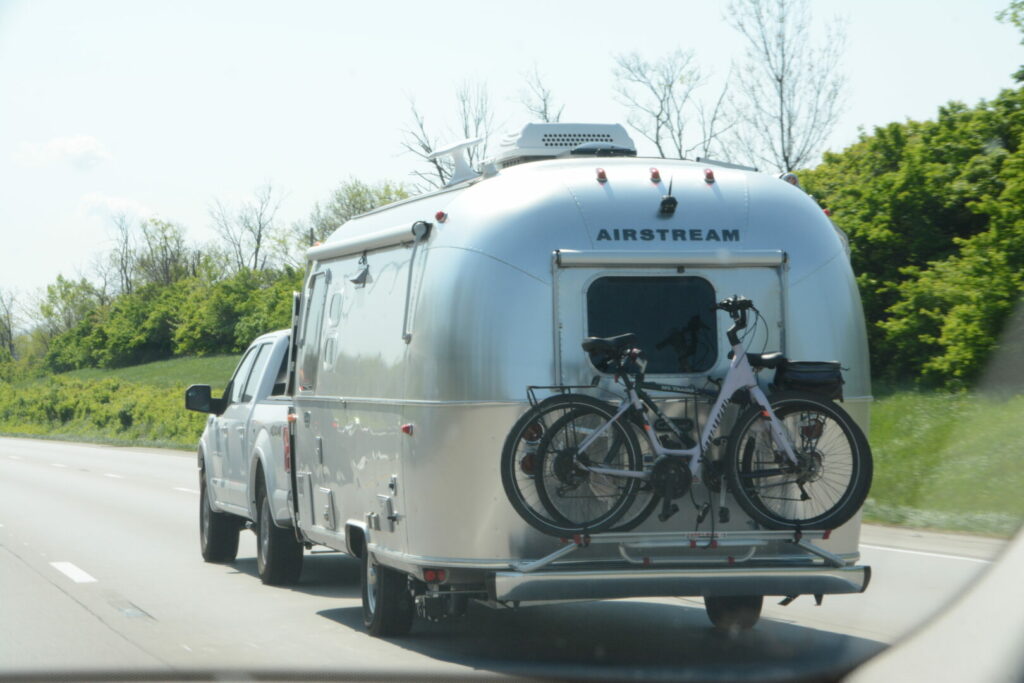Table of Contents Show
Like many communities, RVers have a vocabulary. Boondocking, full hookups, and other terminology can sometimes leave people without RVs wondering what we’re saying. The 2/2/2 rule is another term that may raise eyebrows.
Let’s dive in to learn what the RVing 2/2/2 rule is and why abiding by it could help you have a better RV experience.
What Is the RVing 2/2/2 Rule?
The RVing 2/2/2 rule is a safe and effective way to plan your travel. It means drive no more than 200 miles a day, stop every 2 hours, and stay 2 nights in each place. Some RVers also put an appendix on the rule encouraging drivers to arrive at an overnight destination by 2:00 p.m.
Why Drive No More Than 200 Miles a Day?
Driving 200 miles a day or less is beneficial in multiple ways. First, it keeps you from a long exhausting drive day. Second, limiting your daily mileage can also relieve elongated stress on your RV.
A 200-mile day also gives you time to sightsee or do work. It can make your trip feel less rushed and more energizing.
Why It’s Recommended to Stop Every 2 Hours
Stopping every 2 hours helps you stay alert during your drive. Getting outside to stretch your legs or eat something can give you a boost.
Plus, if your rig has an issue, you’re more likely to notice it early before it becomes a major problem. If something on your RV breaks or needs adjusting, catching it as early as possible is best.

Benefits of Arriving at Your Campsite before 2 p.m.
Aiming to arrive at the place you’re going to stay for the night by 2:00 p.m. ensures you’re stationary before the sun goes down. Navigating a campground in the dark can be very difficult, particularly if you’re traveling alone and don’t have someone to spot you.
Plus, if you arrive in the afternoon, you have the evening to enjoy. And you beat rush hour if you’re near a city.
Driving an RV down the road in the dark can also be dangerous. It’s a big rig to navigate, and it can be challenging to see out of your mirrors with blinding headlights. If you’re driving through deer country, avoiding nighttime driving significantly reduces your risk of hitting wildlife.
Should You Spend A Minimum of 2 Nights in Each Place?
Spending a minimum of 2 nights in each place has its benefits. It gives you a whole day to rest, catch up on work, or go sightseeing. Planning 2 night stays into your trip, whether you use them or not, also allows for a cushion if you’re on any sort of a schedule. For example, if something breaks, it’s best to have a full day to deal with repairs if needed.
Why RVers Use the 2/2/2 Rule
If you’re new to RVing, you may be thinking that stopping every 2 hours and only going 200 miles a day might seem overly cautious. You might have driven 12 hours straight through on road trips before with no problem. So what’s the deal with these rules?
Driving or towing an RV is a lot different than cruising in a vehicle without one. Playing offense and defense on the road becomes more intense. You’re not only paying attention to your driving but constantly watching cars in front, on the side, and behind you. Remember, your RV may be large, heavy, and doesn’t stop as fast as other vehicles. This type of driving can be very tiring, even for the most experienced driver. Thus, the 2/2/2 rule was born.
The rule is a way to keep yourself alert. It’s also a way to experience the most out of your trip. You may miss something significant along the way if your focus is only on getting from point A to B. Traveling slower affords you opportunities to visit attractions and more on the way to your destination.

You could also use the alternative 3/3/3 rule. It’s essentially the same concept, but you’ll drive no more than 300 miles in one day, take a break every 3 hours, stop for the night by 3:00 pm., and stay 3 nights.
There may be times when one of these driving rules doesn’t fit into your plans. For example, sometimes weather or other unforeseen circumstances dictate our travels. Learning to go with the flow is all part of RV life, but having some rules in place can be very helpful.
Other Tips to Prevent Stress on RV Travel Days
You’ll likely come up with other rules for yourself for RV travel days. Here are some additional tips for preventing stress while on the road.
Prep the Night Before
You can relieve the stress of a morning departure by prepping the RV the night before. Get your RV and vehicle ready for travel before you go to bed. While there will be some minimal things you need to do in the morning, the less you have to do, the smoother your day will go.
When getting ready the night before, things to consider might include emptying your black and grey tanks and securing sewer hoses. Perhaps you have a table to break down or other items you secure during travel; have as much of that done as possible the night before.
Head out Early
Departing shortly after the sun rises may be a rule you want to embrace. Early morning traffic is typically light, at least before rush hour hits. Heading out early also keeps you from rushing to make a 2:00 p.m. arrival time. You can take breaks without pressure.

Don’t Drive During Bad Weather
Consider making it a rule not to drive during bad weather, including high winds or heavy rain. The risk of an accident during inclement weather is great when driving an RV. However, your life and others’ lives are worth more than getting to your destination.
There are many apps you can use to watch the weather on your route. We recommend pulling over into a rest area or truck stop if bad weather surprises you.
Know Your Route
Research your route before you depart. Knowing which roads you’ll take will help you follow your GPS and know what to expect ahead. Pay attention to potential low bridges to avoid and where you can get gas or fuel. Apps like AllStays and an RV GPS can help your planning.
It’s also wise to do a Google satellite view of places you’ll be staying overnight. Whether it be a campground or Cracker Barrel parking lot, look at satellite images on Google Maps. This will help you determine which direction to pull into the campground or parking spot. It can also indicate any potential obstacles in your way.
Tell Us What You Think
Try using the 2/2/2 rule on your next RV trip. Evaluate along the way and after your travels to see if you felt less tired. Or perhaps you’ll see more sights than you had before implementing the rule.
The RV community has many great ideas, so let us know what you think about this one. Rules like the 2/2/2 or 3/3/3 can help both you and other RVers.
We would love to hear your thoughts or if you have any travel tips to add.







Great article. Thank you.
One additional thing we consider, is the position of the sun. Driving east shortly after sunrise, while beautiful, puts the sun directly in your eyes. We wait a bit before departing for the sun to get above the visor. Same going west, but the 2-2-2 rule accommodates for the setting sun.
Can I do a 4/4 rule?
400 miles and arrive at a stop over campground by 4pm (It is still light until after 8pm). This will be our first “big” trip in our new RV (Entegra Anthem) and we will have two days to get to the destination (987 miles), three days to visit, and two days to drive back home.